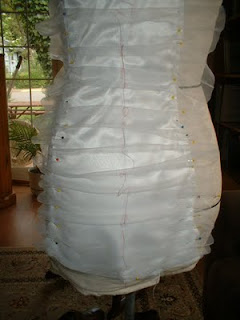Want to learn how to drape? This method will jazz up any basic pattern by adding rows of gathering into
the seam allowance with a little bit of draping. If you've never done
draping before, this is a great way to get started with it.
For my example, I'm using white tricot over satin on a princess seam pattern. Because tricot is a knit fabric, I can drape this with the grain. If you are using a woven fabric, you should drape on the bias. You will need a mannequin to get the right tension and effect on the overlay.
Step 1: Sew the princess seam, or darts of your base layer. Pin it to your mannequin. Cut a rectangle, on grain, a little bit wider than and twice as long as your base.
Step 2: Using a contrast thread, hand baste a thread the length of your rectangle, on grain. I basted mine exactly down the middle. This thread will help you to stay on grain as you gather up the fabric.
Step 3: Starting at the top, pin the overlay, gathering up the fabric as you go, along the seam allowance on both sides.Keep the gathers parallel to the floor. You should have to pull a bit horizontally to keep the gathers taut. Do re-pin and adjust the gathers until you are satisfied with the result.
Step 4: Trim the excess to match the cut line of your base.
To make it easy to sew it the same way you pinned it, use a contrast thread to tailor tack the overlay where the base has notches. If there are long spaces without notches, add tacks to both the base and the overlay. It's really helpful to have points where you know the two match up.
Step 5: Remove the overlay from the mannequin and use it to cut a second
side. If you will be making this style again, you can make a pattern from the overlay by tracing it.
The center basting now becomes a guide for the grain line, and the tacks show where notches should go.
Step 6: Baste two rows of stitches on all gathered sides. Pin overlays on to the base matching the notches and tailor tacks. Sew overlays on top of the base pieces with a long machine stitch. Press.
Your pattern pieces are now ready to be assembled. Happy Gathering!









